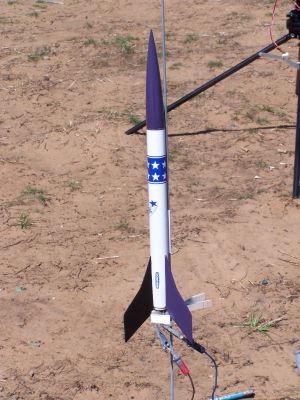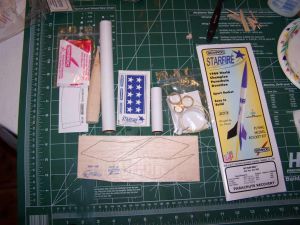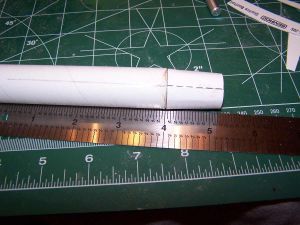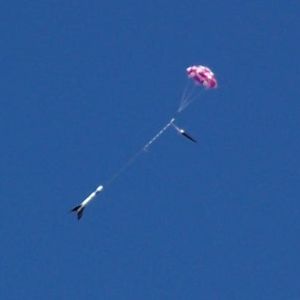| Construction Rating: | starstarstarstarstar_border |
| Flight Rating: | starstarstarstarstar |
| Overall Rating: | starstarstarstarstar_border |
| Diameter: | 0.91 inches |
| Manufacturer: | Semroc  |
| Skill Level: | 1 |
| Style: | Sport |

Brief:
I got this rocket just before Christmas. It is a reproduction of the 1966 parachute duration champion. I'll never use it for that purpose, but it seems to be a neat little kit.
Construction:
The parts list:
- 1 Body Tube ST-880
- 1 Body Tube ST-730
- 1 Balsa Nose Cone BC-848
- 1 Sheet of Laser Cut Fins FV-20
- 2 Centering Rings CR-78
- 1 Thrust Ring TR-7
- 1 Launch Lug LL-122
- 1 Screw Eye SE-10
- 1 Elastic Cord EC-118
- 1 Kevlar Thread SCK-24
- 1 Plastic Parachute RC-12
- 1 Tape Disc TD-6
- 1 Shroud Line SLT-6
- 1 Decal DKV-20
- 1 Cardstock Shroud IKV-205

All parts were present and accounted for.
The instructions were also high quality. They are printed in a booklet, have generous illustrations, and are very clear.
Constructions begins by inserting a thrust ring in the end of the motor mount and gluing it in place. The Kevlar thread is then knotted, slipped through one of the centering rings, and glued into place flush with the end of the motor mount tube. I'm glad I thought ahead on the next step. A mark is made 1 1/8" from the opposite end of the motor tube and the other centering ring is mounted flush with it. Normally, I figure there is some "give" in the measurements of simple rockets. That is a bad assumption. This centering ring needs to be in the right place for the boat tail. I'm glad I remembered in time.
The next step is to mark the body tube for the fins using the fin guide printed in the instructions. An angle is then used to lengthen the line by at least 2 inches.
 The fins practically fall out of the sheet. A light sanding is all that is needed to remove them. I sanded a bevel on all edges except the root edge.
The fins practically fall out of the sheet. A light sanding is all that is needed to remove them. I sanded a bevel on all edges except the root edge.
If there is a tricky part to this build, it is in installing the motor mount to the body tube. 1/16" of a gap from the rear centering ring needs to protrude out from the BT. Getting it mounted and spaced correctly before the glue starts to grab is doable but was not done by me. I dawdled too much and had to use some excessive force.
The boat tail too is a simple affair. It is cut from the cardstock and glued along the tab. In order to do away with the unsightly seam, I was going to try rubber cement but that was unneeded. The seam line will be covered up when the fins are installed. Mounting the boat tail is a simple matter of applying some glue and sliding it on.
Mounting the fins also was simple. I used an Art Rose fin jig to make sure they were straight. I also perforated the root edge of the fins with a safety pin to form glue rivets. Then it's just a matter of waiting and getting some sleep.
The Starfire was taken off of the fin jig and the fins were filleted for strength using yellow glue. I know the yellow glue shrinks but I usually make up for that with filler at the end.
The launch lug was attached with yellow glue in the normal way.
Finishing:
Elmer's Fill 'n' Finish was used to fill all the balsa and to fill the gap between the body tube and the boat tail. That gap was a result of my not moving fast enough to mount the motor tube and was quite unsightly, especially on one side. The high quality of the balsa meant that relatively little was needed on the fins or the nose cone, but the transition from body tube to boat tail needed a lot.
Sanding was easily accomplished and then the rocket was primed with white spray.
My first impression from the face card was that the rocket was basically white with purple fins and nose cone. On closer examination, I was shown to be only partially correct. Two of the fins are purple and one is black. I thought I would like that so I decided to go with it.
I gave the entire rocket 2 coats of white spray and then masked the body and 1 fin. I sprayed the NC and two fins purple. Now I just had to wait overnight so see the first stage of the results.
The purple paint came out looking fine except that it was a good deal darker than I expected. I'm not sure it will provide much contrast with the black I am using on the fin opposite the launch lug. In any event, I masked for the black fin and sprayed it with 2 coats. I think I like the result but the color distinction is much clearer in a photo than in person.
I had a couple of problems with the decals. The first may not be a problem, just a matter of perception. The face card and the website graphic both show the decals as being purple. When I got around to actually looking at them, they burned out to be blue. This was after I had already painted parts of the rocket purple! This was my fault for not looking sooner but I like purple.
The decals themselves consist of a star pattern that wraps around the body tube, a Starfire logo, and 3 small Semroc logos. The quality of the waterslides is high and they went on without any problem except for the wrap pattern. It went on fine too but was not quite big enough to wrap all the way around the BT. There is a gap.
I generally expect better from Semroc because I have always received better from Semroc. Their first class products and first class treatment of me mean that this is easily forgiven.
After the decals set, I applied a coating of Future Floor Polish.
Construction Rating: 4 out of 5
Flight:
For the maiden flight, I used an A8-5. Even with that light motor, the results were incredible.
The rocket was prepped in the usual manner and I used dog barf for wadding. The motor was friction fit and a little masking tape was needed to make it snug.
When the rocket took off, it screamed off the pad. I was sure I had put the wrong motor in it and thought I might lose it. Ejection occurred right at apogee, perfectly with the nose cone up. The chute deployed and then I really got to worry. It opened right away and just hung there as if the law of gravity had been suspended. The wind caught it and continued to move it down range, but it never seemed to get any lower. I was not timing it but I know it stayed up for at least 2 minutes. When it finally did come down, it was a long way away. When I got the rocket back, sure enough, it was just an A8-5.

Recovery:
This rocket was designed for parachute duration and it shows. It stayed up longer than any rocket I have ever launched before.
Coming down so slowly on a 12" chute means that you have to be really careful about the wind. This one is a keeper!
Flight Rating: 5 out of 5
Summary:
This rocket is a superb choice for parachute duration competition. It is easy to build, flies high on a small motor, and hangs in the air forever.
PROs: easy to build, flies high and straight, hangs in the air a long time.
CONs: hang time means it will be easy to lose, especially on a C.
Overall Rating: 4 out of 5
 |
 |
Flights
 |
 |
Sponsored Ads
 |
 |












Chan Stevens (January 1, 2011)
Wish I'd read this review before I built--I also made the mistake of painting fins and nose purple before catching that the decals are really a royal blue, not purple. Wound up adding at least 0.15 ounces for the repaint . The header card/decal mismatch is uncharacteristic for Semroc.
. The header card/decal mismatch is uncharacteristic for Semroc.